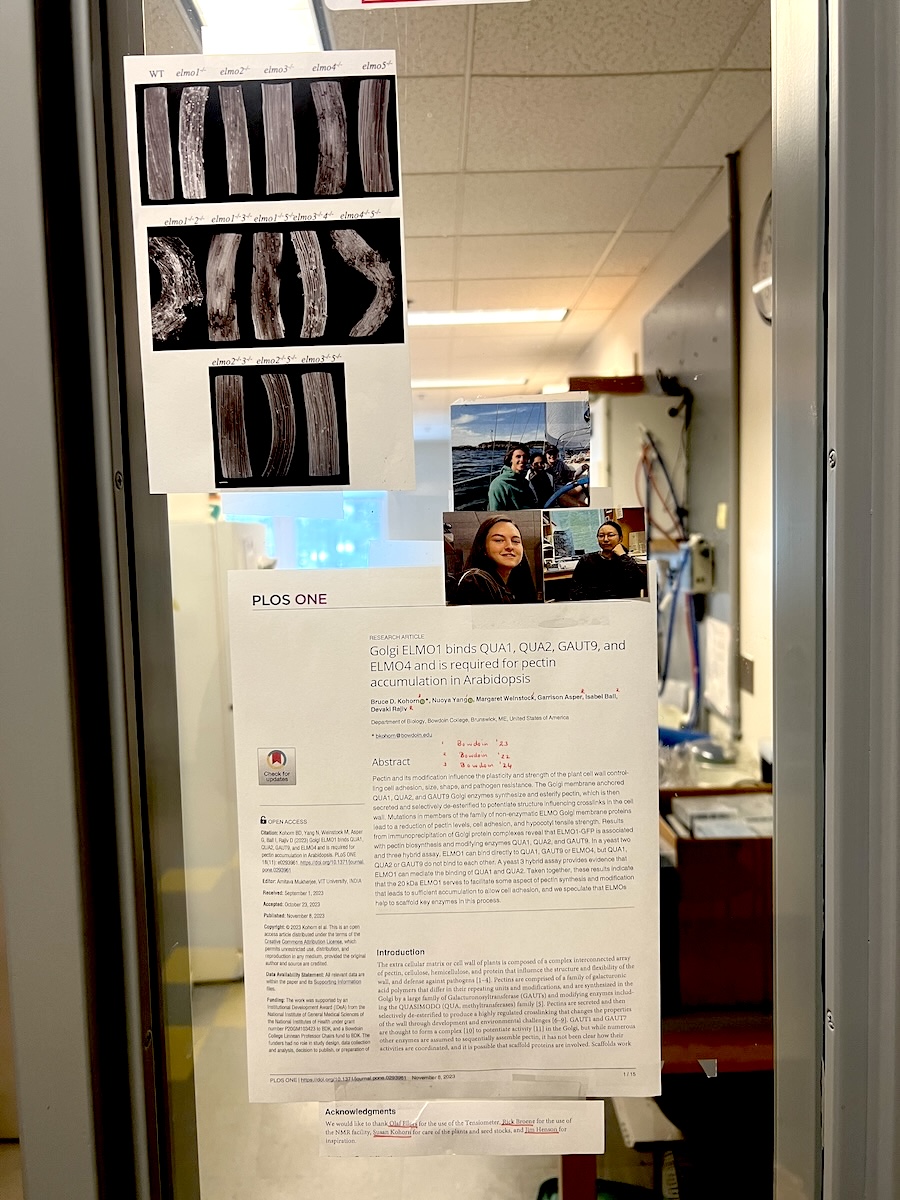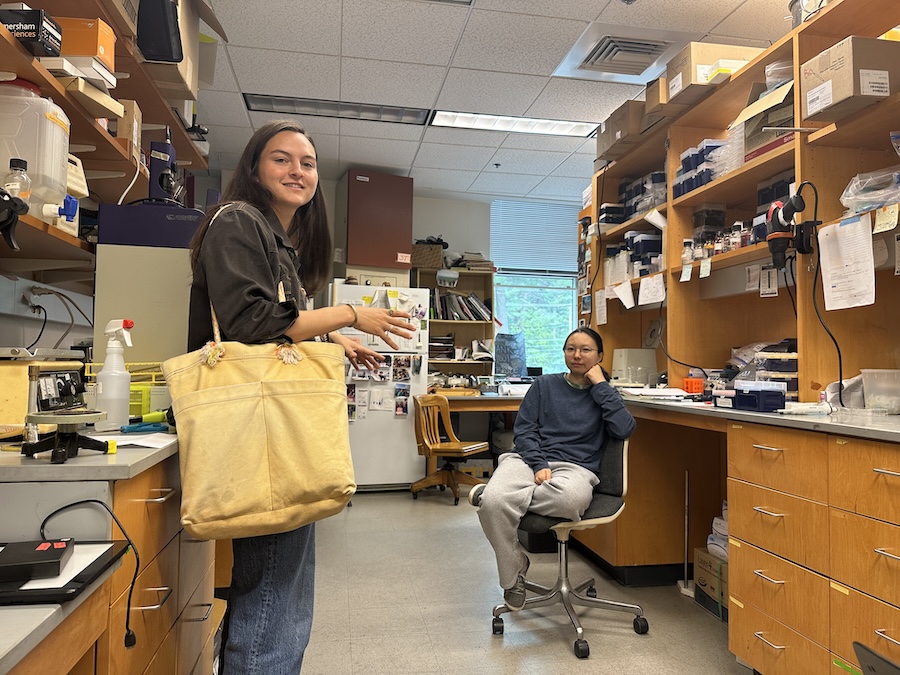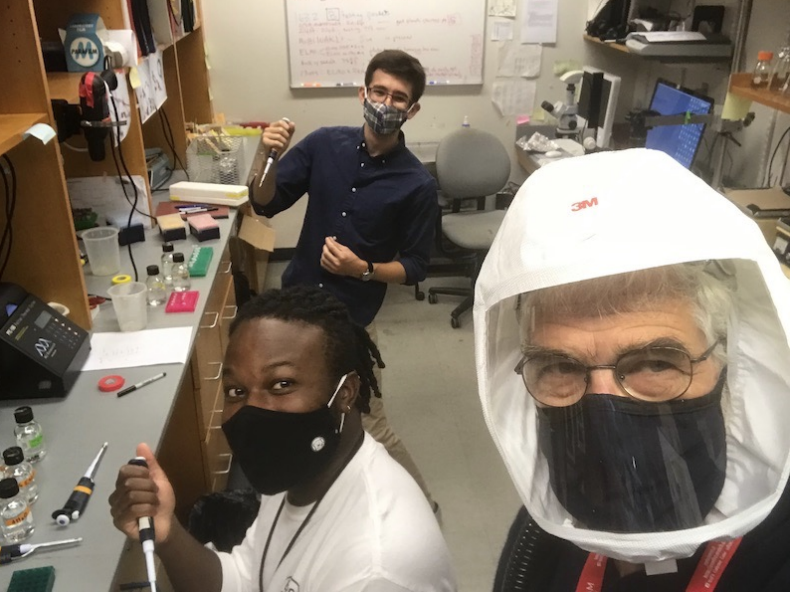Sticking with It: Student Researchers Make Significant Findings in Professor's Plant Science Lab
By Rebecca Goldfine
The article, in PLOS One, a peer-reviewed journal published by the Public Library of Science, reflects the lab's work over the past three years. In that time, Kohorn's team has revealed new information about pectin, a sugar polymer that serves as the glue that sticks cell walls together. Cell walls are critical for maintaining the structure of the plant, abetting plant growth and development, and guarding against pathogens and physical wounds.
Kohorn gives his students a great deal of credit for this feat. Sitting in his Druckenmiller laboratory recently, he cast his mind back over a list of remarkable lab assistants. Most received fellowships from Bowdoin to do research with him over the summers and through the academic year.
"From Frances [Zorensky ’20] and Jacob [Dexter-Meldrum ’20], to Garrison [Asper ’22], Meg [Weinstock ’23], and Laura [Yang ’23]—they have been the most productive, intuitive, and insightful students I’ve ever had," he said. Others have also made important contributions, including Isabel Ball ’22, Devaki Rajiv ’22, Bridgid Greed ’20, Wesley Hudson ’21, and Andy Bolender ’21.
While all the students were intellectually curious, quick learners, and organized workers, Kohorn thinks the nature of the project also brought out the best in them. "We had a simple, directed question, and this clarity helped students and allowed us to understand how plants make and modify cell walls," he said.
"Plants are incredibly complex and we don’t give them enough appreciation. They make everything—and mostly all they need is light. Most people don’t know plants have immune systems as well. There is a lot to be learned by studying the biochemistry of plants." — Garrison Asper ’23
To study the genetics behind cell wall adhesion, Kohorn's team in 2020 first looked for physical deformities in their model plant Arabidopsis, which could reveal mutant genes. After screening thousands of seedlings, Zorensky and Dexter-Meldrum discovered a novel gene that codes for a protein new to science, which they called ELMO.
Before Zorensky and Dexter-Meldrum graduated, they got as far as discovering that ELMO (or rather, a family of ELMO genes) is critical to making structurally sound cell walls. For when ELMO is absent or mutated, cell walls fall apart, fray, and stain red with a dye, creating fuzzy strands the students thought resembled the adorable red Sesame Street character, hence the name ELMO.
But the team wasn't sure why ELMO has such a profound effect on cell walls. "We thought maybe [the mutation] was causing a reduction in pectin," Kohorn said. So his lab needed to find a method to measure the level of pectin.



When Asper, a biochemistry major, began working in Kohorn's lab in 2021, he applied his chemistry and biology knowledge to help answer this question. In another class with Rick Broene, Bowdoin's Charles Weston Pickard Professor of Chemistry, Asper had learned how to use a nuclear magnetic resonance (NMR) machine, which shows the molecular structure of compounds.
"It was impressive how persistent and smart Garrison was," Kohorn said. "He followed some established protocols but adapted the NMR to the current issue in our lab. He was remarkable, and it led us to measure the levels of pectin so we could put it in the new paper," which is titled "Golgi ELMO1 binds QUA1, QUA2, GAUT9, and ELMO4 and is required for pectin accumulation in Arabidopsis."
They also determined that not only was pectin reduced in the presence of ELMO mutations, it also was significantly modified, resulting in a weaker charge that made it less sticky.
When Weinstock and Yang began working with Kohorn in 2022, Kohorn asked them to answer the next logical question in the puzzle: whether ELMO is directly involved in the synthesis of pectin, or if its purpose is to hold things together.
Of Young, Kohorn said, "She is the sort of person you say, 'Can you figure out how to do this?' and she’ll have it done by the following week, she’ll have figured it out." And, "Meg was amazing, she figured out how to analyze microscope data statistically. It was really impressive."
After running experiments, the two students found that ELMO binds to enzymes that in turn make pectin, and that the whole complex—ELMO, enzymes, and pectin—is located in the plant's Golgi apparatus. (These are little lipid bags that eventually fuse to the outside membrane of cells that deposit material onto the wall.)
Furthermore, they noticed that when pectin is secreted out of the Golgi to do its sticky work, ELMO stays put. "ELMO is basically a scaffold," Kohorn said. "It is not enzymatic, it is not a retention protein, it is binding to each of these synthetic enzymes, which work sequentially. It probably holds them all together so they can be more efficient" as they make pectin.
What's exciting about this discovery is that while scientists had known about the role of scaffolding proteins in other developmental processes, they did not realize it was part of cell wall biosynthesis, Kohorn said. All of these findings add details to paint a more complete picture of cell wall adhesion.
While Kohorn and his students have always engaged with science for the joy of gaining new knowledge about life, the applications of this work down the road could lead to breakthroughs in defending agricultural or biofuel crops against pathogens.
Asper, who is currently working as a lab technician in a University of California San Francisco lab studying in vitro enzymology and is applying to graduate programs, said he loved his experience in Kohorn's lab and would be open to building his career around plant science.
"Plants are incredibly complex and we don’t give them enough consideration," he said in a recent telephone call. "They make everything—and all they need is light. Most people don’t know plants have immune systems as well, there is a lot to be learned by studying the biochemistry of plants."
The first laboratory job Weinstock ever had was with Bruce Kohorn. So she started out a bit nervous.
"He’s an incredible teacher," she said recently, taking a break from her work as a clinical assistant at Longwood Pediatrics in Boston. "In the beginning, everything was so new, and he really wants you to move very quickly," she recalled. "It was nerve-wracking and I second-guessed myself a lot. I remember him calling me out on that. He said, 'I know what you’re doing, and I need you to believe in yourself as much as I believe in you, and if you make a mistake it’ll be okay.'"
"He forced me to be okay with making mistakes and more willing to take more risks," she continued, "and that helped me grow up as a student and in the lab." Now she is in the process of applying to medical schools.
Laura Yang ’23 said she met Kohorn when she enrolled in his Biochemistry and Cell Biology course. "That class was so much fun," she said from University of Southern California, where she is a PhD student at the Keck School of Medicine-PIBBS program. "Bruce showed up in a chef’s hat and with a egg, and I said, 'That kind of professor is the kind I want to work with,'" even though plants were a new area of research for her.
Of the experience in his lab, she said, "I truly, truly learned a lot—I not only learned how to do something, but I understood the reason why we designed an experiment this way or that way. I learned the process of troubleshooting—if we encountered a problem in our experiment or a result turned out unexpected, we figured out how to find ways to explain it, or what were alternative approaches."
Asper agreed, reflecting that Kohorn taught his students the fundamentals of experimental design. "That was a fantastic experience, to learn cause and effect—to do an experiment, learn information, ask certain questions, do another experiment—that flow that research is."



